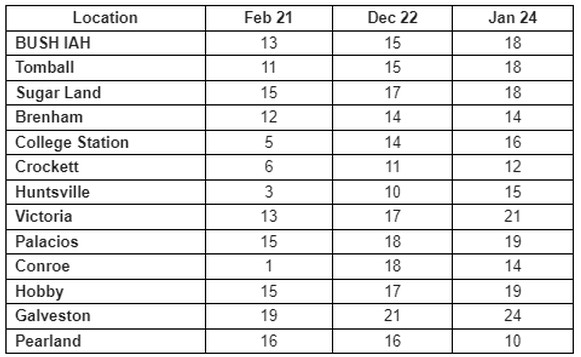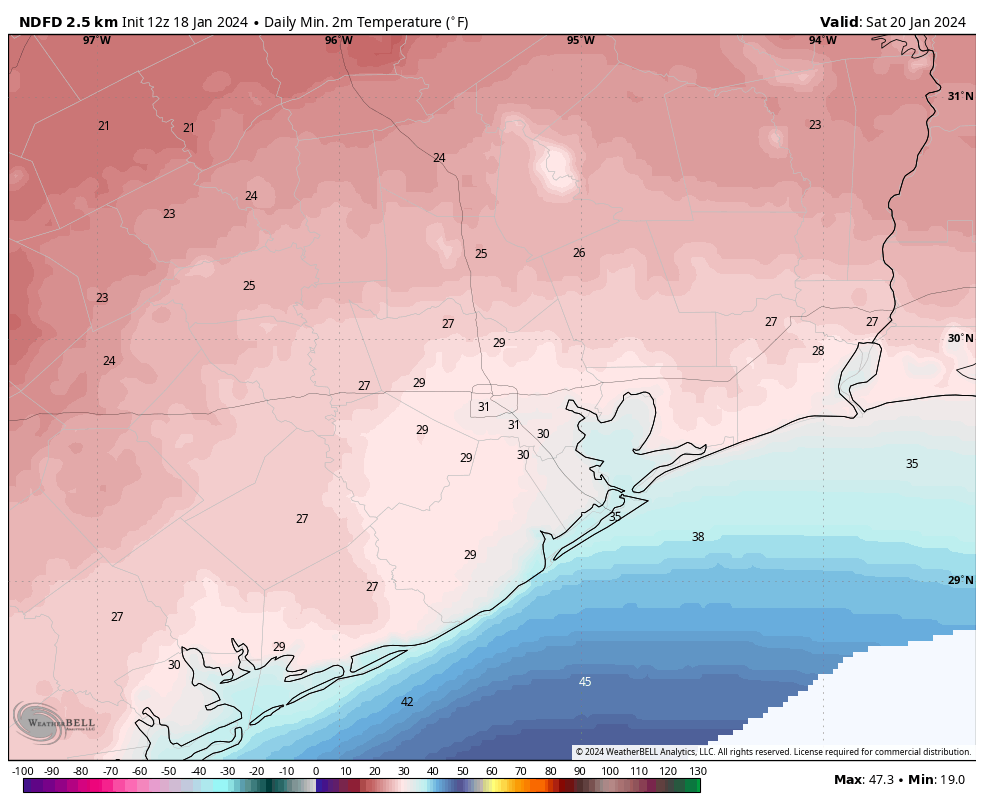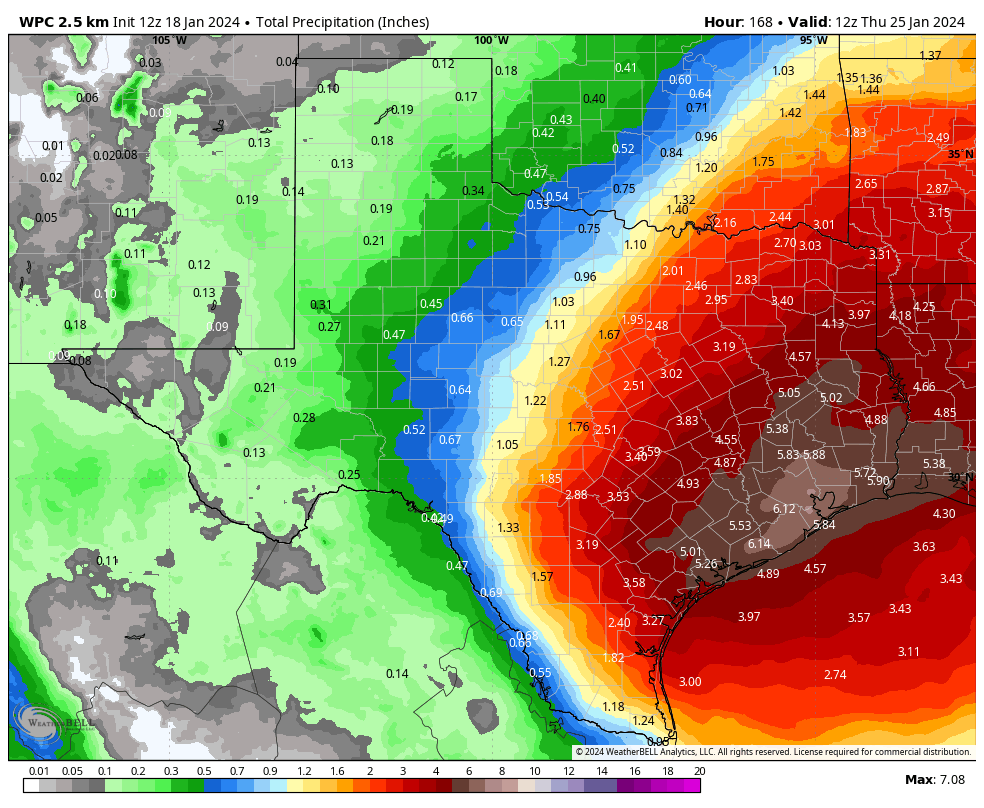Summary: The hard freezes are over, and Houston will have a pleasant, mild, and partly sunny day today. But after that? We’re going to cool back down again for the weekend, and then next week we’ll see widespread rain showers with the threat of heavy rainfall.
Recapping this week’s cold weather
Very hard freezes are supposed to be rather uncommon in Southeast Texas, but our region has now experienced three during the last four winters, in February 2021, December 2022, and January 2024. The worst of these was in 2021, when the cold was its sharpest, and most prolonged, with a winter storm on top of it. But the other two cold snaps, including this week, were significant. Here, via Harris County Flood Control District’s Jeff Linder, is a comparison of the coldest temperatures during each freeze:

Thursday
The combination of light winds and temperatures matching dewpoints has led to foggy conditions across much of the metro area this morning. This should dissipate by around 9 am, but until then please exercise some caution on roadways. Some very light drizzle is also possible this morning.
Winds will increase later this morning, and this southerly flow will help push temperatures into the upper 60s. Skies should be partly sunny, making for a rather nice afternoon. However a fairly robust cold front will sweep into Houston tonight, likely after midnight, to bring a new round of chilly air. Lows drop to around 40 degrees by Friday morning.
Friday
This will be a sunny, breezy, and cool day. Look for highs to reach the lower 50s. Winds will peak during the morning hours, with gusts up to about 30 mph possible as the front blows in. These should subside somewhat during the afternoon, with mostly sunny skies. We’ll see ideal conditions for cooling overnight, and much of the metro area could see a light freeze.

Saturday
This will be a chilly day, with highs in the 40s and partly sunny skies. Lows on Saturday night will probably be a touch warmer than Friday night, but a light freeze will again be possible in parts of the area.
Sunday
Clouds return by Sunday, and they’re going to stay awhile. This will be another chilly day, although highs should get into the low 50s. Some light rain showers will be possible later in the day, but for now I think they’ll hold off until overnight when temperatures drop into the 40s.

Next week
Most of next week looks warm and wet, with highs in the vicinity of 70 degrees, and nights perhaps in the upper 50s. As a series of disturbances cross Texas and meet with a favorably moist atmosphere, we’re going to see a fair amount of rainfall. I still don’t feel overly confident in totals, but I think much of the area probably will see on the order of 2 to 8 inches through Friday. Whether all of this comes in bunches, and we have to worry about flooding, is another matter. In any case, prepare for a significant pattern change that will bring a new round of concerns beginning next Monday or so.


How many hours was Houston below freezing this week?
Everyone else keeping their outdoor plants inside till Monday? 🙁
Yes. House looks like a garden center. 40F is kind of the cutoff for most tropical I think….The planted queen palms may have survived too. Some fronds looking like old lettuce but some look vibrant.
I put them out for yesterday afternoon and today.
Maybe, but my outdoor plants all died, so not too interested right now. The USDA allegedly changed Houston to Zone 9A, and that was probably propaganda to tell us that the planet is heating up.
Propaganda? The U.S just had its warmest December on record last month, and it quickly broke it too. The previous record was just recently in 2021.
USDA zones are based on minimum winter temps, not average or high temps. They should’ve changed Houston to 8A or 7B instead of 9A, but that would’ve gone against the narrative. 9A plants clearly can’t survive our winters.
Agree with this. Assume 8A and you’re good. We’ve always been listed 9A which only works to 25F. So you’re replanting queen palms and the like every few years or more lately. They grow fast. The plants with rhizomes in the earth (think bananas) are OK tho. Even down to low teens. The URBAN CORE and south is now listed 9B which is 30F. That’s fantasy I’m afraid, but the garden centers make money.
One additional thing to understand is the zones are based on an average of minimum temps of each winter over the past 30 winters. So if you have 20 winters with a low of 30, 5 winters with a low of 25 and 5 winters with a low of 12, that is still only 26 degrees on average which puts us right in 9b. I think this scenario is probably pretty close to what we are getting in Houston over the past 30 years. These past 3 of 4 winters have been extremely harsh for those couple days each winter.
9A – 20-25F (Montgomery County)
9B – 25-30F (Harris County)
From the USDA PHZM website: “The map is based on the average annual extreme minimum winter temperature” but also “The longer period (30 years) of data in the 2012 and this 2023 version was selected [to] smooth out the fluctuations of year-to-year weather variation.”
As noted in the post, over the last 30 years, hard freezes were more rare, so the average low end of winter temps would be higher.
Really Jason? I would have thought you’d have a higher intellect than making that comment.
Maybe my intellect is bad, but back in the summer, the Houston Institute of Forensic Sciences had a big listing of “heat related deaths,” almost all of which occurred at Memorial Hermann Hospitals, for some reason. I asked them if they were going to list “cold related deaths,” after this cold snap, and they aren’t sure. It is known that cold kills more people than heat.
Obviously, but you think Houston has more cold than heat? Once May ends, the hoping for no 100 degree days ritual starts until October.
From the USDA PHZM website:
“Climate changes are usually based on trends in overall annual average temperatures recorded over 50-100 years. Because the USDA PHZM represents 30-year averages of what are essentially extreme weather events (the coldest temperature of the year), changes in zones are not reliable evidence of whether there has been global warming.”
USDA is not only NOT propagandizing climate change, they are very clear that this data could not indicate climate change.
Please do a little homework before making accusations that erode public trust in science.
Thank you. You said it way better than what I was going to write.
Y’all need to relax? I thought we were talking about the practical implications of the published USDA hardiness zones. Especially for people new living here. Averages are great but if you buy plants with hardiness zone 9B they won’t last long. Arctic air is never far away. That’s all I’m saying. Geesh.
Sad that you thing the planet suffering through increased warming is propaganda. Pull your head out of your prideful behind and stop licking the boots of right wing politicians. Or any for that matter. I don’t even care for politics and I know the science that shows the planets trending heating. Wake up sheeple.
Exactly. Your politicians are telling you this because they receive huge amounts of money from the Oil and Gas industry.
I’ve got my Washington Navel Orange tree back outside to try to soak up the sun while it has the chance today and tomorrow. It’s supposed to be resistant to light freezes, but I’m going to bring it back in Friday night.
Yes!
Conroe got to 1 degree in 2021?
Huntsville was down to 3.
So are hard prolonged freezes the new normal for our area every winter? If so, I could probably plant some maple trees in my yard since they need a hard freeze to properly go dormant.
A lot of maple trees did really poorly in the drought this summer though. I was thinking of planting one in my yard until I saw that.
Yeah, If we’re going to be experiencing very hot summers with prolonged drought months, and regular deep freeze shocks in the winter from an unstable polar vortex, I would think our hardy plant species list will only shrink. The native plants are mostly holding up okay though.
We live here in Santa Fe and I have several varieties of maple trees which are, 3 Southern sugar maples, 1 Drummond red maple, 2 Summer red maples and a Freeman maple, which is a cross between a red and silver maple. Some of these trees are close to 30 years old now and I’ve never had a problem with any. Not only that, but my Southern sugar maples are the most reliable when it comes to fall color.
If long term climate changes, new plants move in and become “native.” What’s native here today wasn’t 10,000:years ago. Nature is constantly in flux.
Except the climate extremity the globe currently has is happening within just 100 years, not 10,000.
I doubt the Pearland number for this month is right. I live near Ellington and it only got down to 21 at my house. And I’m measuring away from the house at about 5 ft (rather than 2m).
5 feet away from your house is still quite heat trapping compared to the massive fields weather stations normally record on 2m off the ground and in fhe shade.
I am curious how you gauge rain totals as the GFS has been pegging us for more like 12” thru Friday. And several runs for that matter. Please advise about the analysis used. Thanks
I think your table on low temperatures for Pearland for 2024 has a typo @ 10 Should be a 19.
In February 2021 I walked around the neighborhood with my son and we saw several houses with broken pipes, specifically at the little exposed area where the water pipe from the main comes above ground and enters the house (a very dubious design if you ask me). In 2022 and this year, no broken pipes at that exposed area. Also in Feb 2021, despite my best efforts a water pipe in my laundry room froze–but no pipes froze in 2022 and this year. Anyway, perhaps you can tell that my main problem with these hard freezes is anxiety over pipes.
For as long as I can remember, whenever there’s been a freeze, we drip all faucets hot and cold, then I wash one or two hot water loads of laundry during the night and run the dryer. Also run the dishwater. It’s become a ritual now. Moved here in 1959, my parents did it, never had a pipe freeze. It does require staying up most of the night(s), though.
It is standard practice in this area to run pipes in the attic rather than under the slab. Not the best way to ensure pipes remain unfrozen during extreme freezing spells. The only way to change that is for you to have your own house built and to insist the main line enters under the slab and rises up to the taps and heater. It is quite possible you’d have resistance for the city inspector though who does not like any kind of change to the process.
Quote: “A fairly robust cold front will sweep into Houston tonight, likely after midnight”,.. I really wish someone out there could give me a theory or maybe even something factual on why the fronts mostly arrive here, just south of Houston, during the night or wee hours of the morning. Thanks.
Curious about the broken pipes stories and maybe I’m missing some detail. I’ve used both these options successfully – shut off at the street, then drain and secure all house lines. OR run bleeders inside and out so lines can’t set up. Total shut down was necessary for 2021 because the city stopped supplying water. This year I just opened outdoor bleeders.
Draining did not work at my former home in League City back in the 80s when it got down to 8 F. The pipes froze and broke at three low spots. Then again it was a poorly built starter home built by General Homes, an el-cheapo builder.
In our house, we have water lines coming up through our slab. Trust me, it is not a perfect solution. Slab move. Up and down. In response to the swelling and shrinkage of local clayey soils. Which is caused by alternating wet and dry weather periods. Such slab movement can, and has, resulted in wearing through the copper pipe, leading to leaks, loss of water supply, and flooding of my home. And it happens to homes more often than you would think and clearly more than you know.
Pier and beam here. But I get what you’re saying. Inflexible on gumbo is bad. As for low points mentioned above I think I will need to scope those out for next time. Definitely vulnerable to that.
Where’s the sun?!
Ah, at the center of the solar system?
Wasn’t 2018 mid-January a very similar pattern as what we just saw this week? Also an El Nino year, so curious how that affects our freeze patterns.
That last part. What does that mean?
“…February 2021, December 2022, and January 2024.” – this is three consecutive winters – that’s three of the last three winters…